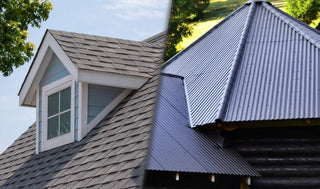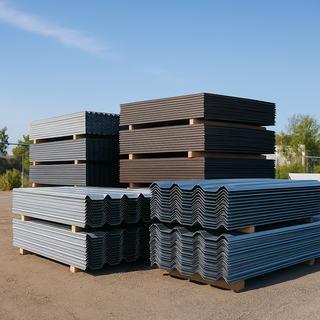Choosing the right roofing material is a critical decision for homeowners, impacting everything from the home's aesthetic to its durability and maintenance requirements. This detailed comparison of metal, asphalt, and clay roofing materials will help you make an informed choice based on your specific needs and preferences.
1. Metal Roofing
Advantages:
- Durability: Metal roofs can last 40-70 years, depending on the material type and maintenance. They are resistant to cracking, shrinking, and erosion, and can withstand extreme weather conditions including heavy snow, hurricanes, and high winds.
- Energy Efficiency: Metal roofs reflect solar radiant heat, which can reduce cooling costs by up to 25%. They are also excellent for mounting solar panels.
- Environmentally Friendly: Most metal roofing materials are made from 30-60% recycled content and are 100% recyclable at the end of their lifespan.
- Style Variety: Available in a range of styles, colors, and finishes, metal roofing can suit any architectural design.
Disadvantages:
- Cost: Initial installation costs are higher than asphalt but comparable to high-quality clay tiles.
- Noise: Without proper insulation, metal roofs can be noisier during rain or hail compared to other types.
2. Asphalt Shingles
Advantages:
- Cost-Effectiveness: Asphalt shingles are among the most affordable roofing options, making them a popular choice for many homeowners.
- Ease of Installation: Asphalt shingles are relatively easy to install, and many homeowners choose to do the installation themselves.
- Versatility: They come in various colors and styles and can fit a wide range of architectural designs.
Disadvantages:
- Shorter Lifespan: Typically, asphalt shingles last about 15-30 years, which is shorter than metal and clay options.
- Vulnerability to Weather: They can be damaged by high winds and extreme temperatures and tend to degrade faster than metal or clay.
3. Clay Tiles
Advantages:
- Longevity: Clay tiles can last over 100 years if properly maintained. They are incredibly durable and resistant to rot, fire, and insect damage.
- Aesthetic Appeal: Clay tiles offer a classic look that is preferred for historical and high-end homes. They also come in a variety of natural colors.
- Thermal Properties: Clay has excellent thermal properties, keeping homes cooler in hot climates and warmer in cold climates.
Disadvantages:
- Weight: Clay tiles are heavy, requiring additional roof support which can be costly.
- Cost: They are generally more expensive than both metal and asphalt, both in terms of materials and installation.
- Fragility: Despite their durability, clay tiles can break under impact, making them more susceptible to damage from hail or falling debris.
Conclusion
Each roofing material offers unique benefits and drawbacks. Metal roofing stands out for its durability, energy efficiency, and sustainability, making it an excellent choice for homeowners looking for a long-term investment. Asphalt shingles are a budget-friendly option suitable for a wide range of styles, while clay tiles offer unparalleled longevity and classic appeal for luxury homes.
Before making a decision, consider factors such as climate, budget, and the structural capacity of your home. Consulting with a professional roofer can provide further guidance tailored to your specific circumstances.
For more detailed comparisons and to explore a wide range of roofing options, visit TopTierMetals.com.






